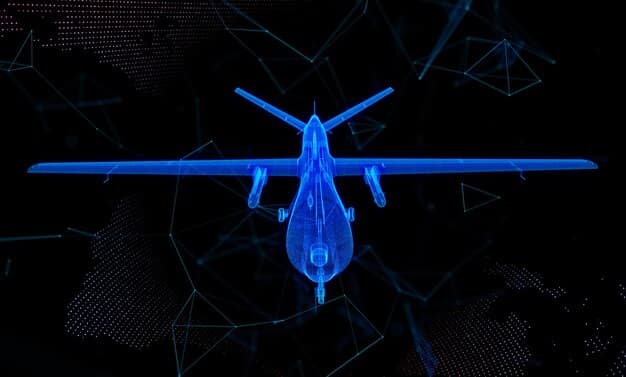Defense Tech Innovation: Top 5 Emerging Technologies

Defense industry innovation is rapidly evolving, driven by transformative advancements in areas such as artificial intelligence, autonomous systems, hypersonics, directed energy, and advanced materials, fundamentally redefining military capabilities and strategic landscapes.
The landscape of global defense is perpetually shifting, propelled by an unwavering pursuit of technological superiority. In an era marked by rapid change, understanding Defense Industry Innovation: What are the Top 5 Emerging Technologies Transforming the Sector? becomes critical. These innovations aren’t merely incremental improvements; they represent fundamental shifts, poised to redefine national security and warfare as we know it.
The Dawn of Autonomous Systems
Autonomous systems are at the forefront of defense innovation, fundamentally reshaping military operations from surveillance to direct engagement. These systems, ranging from unmanned aerial vehicles (UAVs) to autonomous ground vehicles (AGVs) and maritime drones, are designed to operate independently or with minimal human intervention. Their integration into defense strategies promises to enhance speed, precision, and reach, while significantly reducing human risk in hazardous environments.
The capabilities of autonomous systems extend far beyond simple remote control. Modern iterations incorporate complex algorithms and machine learning, allowing them to adapt to dynamic situations, make real-time decisions, and even cooperate with other autonomous units. This self-sufficiency is a game-changer, enabling prolonged missions, operation in contested areas, and rapid response times that traditional manned systems cannot match.
Unmanned Aerial Vehicles (UAVs)
UAVs, commonly known as drones, have transitioned from niche reconnaissance tools to versatile platforms for various defense applications. Their evolution includes increased endurance, enhanced payload capacities, and sophisticated sensor arrays. They can perform critical tasks without risking human pilots, making them indispensable for intelligence gathering and precision strikes.
- Enhanced reconnaissance and surveillance capabilities.
- Precision strike operations with reduced collateral damage.
- Logistics and transport in complex terrains.
- Swarm intelligence for coordinated attacks and defense.
Autonomous Ground and Maritime Vehicles
On land and at sea, autonomous vehicles are transforming logistical support and operational presence. AGVs can undertake dangerous missions like mine clearance or provide invaluable support in convoy operations, reducing the exposure of personnel to threats. Similarly, unmanned surface and underwater vehicles (USVs and UUVs) are revolutionizing maritime surveillance, anti-submarine warfare, and mine countermeasures, offering persistent presence in vast oceanic environments.
The ethical implications of fully autonomous weapon systems, often referred to as “killer robots,” remain a significant debate. While the technology progresses rapidly, international discussions focus on the need for meaningful human control in lethal decision-making processes. Balancing technological advancement with moral and legal frameworks is paramount for the responsible deployment of these powerful tools.
As these systems become more sophisticated, their integration poses challenges related to cybersecurity, command and control, and interoperability across different military branches and allied forces. Yet, their potential to augment human capabilities and provide a strategic advantage makes them an undeniable cornerstone of future defense strategies.
Artificial Intelligence (AI) and Machine Learning (ML)
Artificial Intelligence and Machine Learning are no longer concepts from science fiction; they are actively reshaping the operational capabilities of modern militaries. AI’s ability to process vast amounts of data, identify patterns, and make predictions at speeds far exceeding human capability is fundamentally transforming defense. From enhancing intelligence analysis to optimizing logistical chains, AI and ML are becoming indispensable tools for decision-makers and frontline personnel alike.
The application of AI in defense is incredibly broad. It ranges from predictive maintenance for complex machinery to advanced threat detection in cyber warfare. AI algorithms can sift through terabytes of sensor data, satellite imagery, and intercepted communications in real-time, extracting critical insights that would be impossible for human analysts to uncover with the same speed and accuracy. This accelerates the decision-making cycle, providing a crucial advantage in fast-paced military engagements.
Intelligent Data Analysis and Fusion
AI’s prowess in handling big data is particularly vital for intelligence, surveillance, and reconnaissance (ISR) operations. ML algorithms can analyze disparate data sources—thermal imagery, radar signals, communication intercepts—and fuse them to create a comprehensive understanding of the battlespace. This leads to more accurate intelligence assessments and reduces the “fog of war.”
- Automated anomaly detection in vast datasets.
- Predictive analytics for enemy movements and intentions.
- Real-time threat assessment and prioritization.
Enhanced Battlefield Awareness
Beyond analysis, AI contributes directly to battlefield awareness. AI-powered sensors and communication networks can provide soldiers with a constantly updated, rich picture of their surroundings, identifying friendly and enemy forces, potential hazards, and optimal routes. This situational awareness is critical for mission success and troop safety.
Moreover, AI is pivotal in cyber defense, where it is used to detect, analyze, and respond to cyber threats at machine speed. As cyberattacks become more sophisticated, human reaction times are often too slow, making AI a vital first line of defense. AI can identify malicious code, predict attack vectors, and even automate countermeasures, protecting critical infrastructure and military networks.
The ethical considerations surrounding AI in defense are as complex as its potential benefits. Concerns exist about biases in data, the potential for autonomous decision-making in lethal contexts, and the need for robust testing and validation to ensure reliability. Despite these challenges, the transformative potential of AI to enhance operational efficiency and strategic insight ensures its continued development and integration into defense systems.
The Progression of Hypersonic Technologies
Hypersonic technologies represent a significant leap forward in military capabilities, offering unparalleled speed and maneuverability that fundamentally challenge existing defense paradigms. Traveling at speeds exceeding Mach 5 (five times the speed of sound), hypersonic weapons drastically reduce reaction times for adversaries, making traditional intercept systems less effective. This characteristic introduces a new dimension to strategic deterrence and power projection.
There are generally two categories of hypersonic weapons: hypersonic glide vehicles (HGVs) and hypersonic cruise missiles (HCMs). HGVs are launched by a rocket to a high altitude before detaching and gliding to a target, using their maneuverability to evade defenses. HCMs, on the other hand, are powered by air-breathing engines, such as scramjets, which allow them to sustain hypersonic speeds within the atmosphere.
Strategic Implications of Speed and Maneuverability
The extreme speed of hypersonic weapons means that a target could be struck within minutes of launch, offering very little warning time. Combined with their ability to maneuver unpredictably in flight, they pose a formidable challenge to current missile defense systems, which are designed to intercept more predictable ballistic missile trajectories. This capability potentially shifts the balance of power, creating new strategic dilemmas for nations.
- Drastically reduced reaction times for targeted nations.
- Evasion capabilities against current missile defense systems.
- Enhanced strike capabilities for conventional and potential nuclear payloads.

Development and Countermeasures
Several global powers are actively engaged in the research and development of hypersonic weapons, viewing them as essential for maintaining strategic parity or achieving a tactical advantage. This race to develop and deploy effective hypersonic systems is escalating, influencing defense budgets and research priorities worldwide.
The development of countermeasures against hypersonic threats is equally urgent. This involves investments in next-generation sensor technologies that can detect and track these fast-moving objects, as well as the exploration of new interceptor concepts. Developing a robust defense against hypersonics requires a multi-layered approach, leveraging advanced AI for threat assessment and rapid response.
The advent of hypersonic technologies underscores the continuous evolution of military hardware and the constant need for innovation in defense. While they offer significant offensive advantages, they also spur a new arms race and highlight the critical importance of international dialogue on arms control and strategic stability in an era of unprecedented speed.
Directed Energy Weapons (DEWs)
Directed Energy Weapons (DEWs) represent a revolutionary shift in warfare, moving away from kinetic projectiles to focused energy. These systems, which include high-energy lasers (HELs) and high-power microwaves (HPMs), offer the potential for precision strikes at the speed of light, with reduced logistical burdens and lower costs per engagement compared to traditional munitions. DEWs harness concentrated energy to damage or destroy targets, or to disrupt their electronic systems without observable projectiles.
HELs use intense beams of light to heat, melt, or vaporize targets, making them highly effective against drones, rockets, artillery shells, and even certain types of missiles. Their precision can minimize collateral damage, and their “magazine depth” is limited only by power supply, offering the potential for virtually unlimited engagements as long as power is available.
HPMs, on the other hand, emit powerful bursts of electromagnetic energy that can overload and disrupt electronic systems, effectively deactivating enemy equipment without physical destruction. This capability is particularly valuable for disabling hostile communication networks, sensors, or even the control systems of autonomous vehicles.
Advantages of Directed Energy
The benefits of DEWs in a combat scenario are manifold. Their ability to engage targets at the speed of light provides an instantaneous response capability. The cost per shot is significantly lower than that of traditional missiles or bombs, as it primarily involves the cost of energy rather than expensive ordnance that is expended. This economic advantage is crucial for sustained defensive operations, particularly against swarm attacks by drones or repeated rocket barrages.
- Speed-of-light engagement, offering minimal reaction time for adversaries.
- Low cost per shot, enabling economically viable defense against numerous threats.
- Precision targeting, reducing the risk of collateral damage in complex environments.
- Broad applicability against a range of aerial and electronic threats.
Challenges and Future Development
Despite their promise, DEWs face several technical hurdles. Achieving sufficient power levels to effectively neutralize hardened targets, managing thermal issues, and ensuring atmospheric propagation stability (as energy beams can be affected by weather conditions) are ongoing challenges. Miniaturization for integration onto various platforms, from ground vehicles to aircraft, is also a key area of research.
However, significant progress has been made, with various prototypes and operational testbeds demonstrating their viability. The focus is now on scaling these technologies for wide-scale deployment and integration into existing defense architectures. As DEWs mature, they are expected to play a crucial role in air defense, missile defense, and naval protection, transforming defensive capabilities and potentially altering the calculus of military engagement.
The silent, instantaneous, and seemingly limitless nature of directed energy adds a new dimension to modern warfare, promising a future where defense is not always about interception but often about immediate, precise neutralization of threats.
Revolution in Advanced Materials
Innovations in advanced materials are quietly but profoundly revolutionizing every aspect of defense technology, from enhancing the protective capabilities of armor to improving the performance of electronic systems and reducing the weight of critical components. These materials, engineered at the atomic and molecular level, offer unprecedented combinations of strength, lightness, durability, and specialized functionalities that were once considered impossible.
The pursuit of stronger yet lighter materials is ceaseless in defense. Traditional metals like steel and aluminum are increasingly being supplemented or replaced by cutting-edge composites, ceramics, and alloys. These new materials are not only providing superior protection against ballistic and explosive threats but are also enabling the design of more agile and fuel-efficient platforms for air, land, and sea. Reduced weight translates directly into increased speed, longer range, and greater payload capacity.
Lightweight Composites and Nanomaterials
Composite materials, such as carbon fiber reinforced polymers, offer exceptional strength-to-weight ratios, making them ideal for aircraft fuselage, body armor, and vehicle components. Nanomaterials, which exploit properties emerging at the nanoscale, are opening up even more possibilities. Nanotubes and graphene, for instance, promise materials that are even stronger, lighter, and more conductive, potentially leading to truly revolutionary defense applications.
- Superior strength-to-weight ratios for enhanced vehicle performance.
- Improved ballistic protection for personnel and platforms.
- Reduced radar cross-section for stealth applications.
Smart Materials and Adaptive Structures
Beyond passive properties, the development of “smart materials” is enabling adaptive structures that can change their properties in response to external stimuli. These include self-healing materials that can repair damage autonomously, shape-memory alloys that can revert to their original form after deformation, and piezoelectric materials that convert mechanical energy into electrical energy (and vice versa). Such materials could lead to aircraft wings that self-repair in flight, or armor that stiffens on impact.
The integration of advanced materials also includes stealth technologies. Materials designed to absorb or scatter radar waves, or to manage thermal signatures, are crucial for making platforms less detectable. This continuous innovation in material science is not just about making things tougher or lighter; it’s about enabling entirely new functionalities and operational concepts for future defense systems.

From individual soldier equipment to grand strategic assets, advanced materials are a pervasive and foundational element of defense innovation. Their ongoing development ensures that future military capabilities will be increasingly robust, efficient, and capable of operating in increasingly complex and demanding environments.
Quantum Technologies: The Next Frontier
Quantum technologies, though often residing in the realm of theoretical physics and advanced laboratories, are poised to become the next major disruptive force in defense. Leveraging the unique properties of quantum mechanics—superposition, entanglement, and tunneling—these technologies hold the potential to revolutionize sensing, communication, and computation, offering capabilities far beyond what classical physics allows.
Perhaps the most discussed application is quantum computing. A functional quantum computer could solve certain complex problems currently intractable for even the most powerful supercomputers, including breaking modern encryption standards, optimizing logistics on an unprecedented scale, and simulating complex systems like new materials or environmental models with extreme precision. This would have profound implications for cybersecurity and strategic planning.
Quantum Sensing and Communication
Beyond computation, quantum sensing promises a new era of precision. Quantum sensors could detect minute changes in gravity, magnetic fields, or acceleration with extraordinary accuracy, potentially leading to vastly improved navigation systems that don’t rely on GPS, or new methods for detecting submarines or hidden underground facilities. Imagine a compass that never loses its bearing, or a radar that can see through jamming and stealth.
- Ultra-precise navigation independent of external signals.
- Detection of previously undetectable anomalies.
- Unbreakable communication through quantum cryptography.
Implications for Cybersecurity and Resilience
Quantum communication, specifically quantum key distribution (QKD), offers a solution for inherently secure communication that is provably unhackable. By encoding information in quantum states, any attempt at eavesdropping would disturb the quantum state, alerting the communicating parties. This would be a game-changer for protecting sensitive military communications and data.
However, the development of true quantum technologies is extremely challenging, requiring stable quantum states and sophisticated control. Many applications are still in early research phases, and significant engineering hurdles remain before large-scale deployment is feasible. Yet, the strategic implications are so vast that nations worldwide are heavily investing in quantum research, knowing that mastery of these technologies could confer an insurmountable advantage.
The “quantum race” is on, driven by the understanding that whoever achieves practical quantum superiority first could reshape global power dynamics. While still emerging, quantum technologies represent the furthest frontier of defense innovation, promising capabilities that will redefine security and warfare for generations to come, from information supremacy to unparalleled detection capabilities.
Challenges and Ethical Considerations in Defense Innovation
The relentless pace of defense innovation, while promising revolutionary capabilities, is not without its complex set of challenges and profound ethical considerations. As new technologies emerge, they introduce unforeseen risks and necessitate a continuous re-evaluation of established norms, guidelines, and international laws. Balancing rapid development with rigorous oversight and responsible deployment is paramount to ensuring these advancements serve, rather than undermine, global security.
One of the primary challenges is the inherent dual-use nature of many emerging technologies. Innovations in AI, robotics, or advanced materials, while developed for defensive purposes, can also be adapted for offensive applications by state and non-state actors alike. This ambiguity can lead to an arms race, where countries feel compelled to develop or acquire these technologies to avoid being at a strategic disadvantage, potentially destabilizing global power balances.
Ethical Dilemmas of Autonomous Systems
The ethical implications of autonomous weapon systems are perhaps the most hotly debated. The concept of machines making lethal decisions without meaningful human intervention raises fundamental questions about accountability, humanity, and the very nature of war. Who is responsible when an autonomous system makes an error or causes unintended harm? The international community is grappling with the need to establish clear boundaries and safeguards to ensure human control over lethal force, exemplified by ongoing discussions at the United Nations.
- Maintaining human control over lethal decision-making.
- Addressing accountability in autonomous system failures.
- Preventing unintended escalation due to automated responses.
Cybersecurity and System Vulnerabilities
As defense systems become increasingly interconnected and reliant on software, they also become more vulnerable to cyberattacks. A sophisticated cyberattack could cripple critical infrastructure, compromise sensitive data, or even incapacitate military platforms, leading to catastrophic consequences. Ensuring the resilience and security of these complex technological networks is a perpetual and escalating challenge, requiring constant vigilance and innovation in cyber defense.
Moreover, the rapid integration of advanced technologies demands continuous training and adaptation for military personnel. The skills required to operate, maintain, and ethically deploy these sophisticated systems are vastly different from traditional military training. There’s a persistent need for workforce development to bridge the gap between technological capabilities and human expertise.
Finally, the economic implications of defense innovation are significant. Research, development, and procurement of cutting-edge technologies are incredibly expensive, leading to difficult choices about resource allocation and potentially widening the military technology gap between nations. Addressing these challenges requires not only technological prowess but also robust policy frameworks, international cooperation, and a shared commitment to responsible innovation for peace and security.
| Key Innovation | Brief Impact |
|---|---|
| 🤖 Autonomous Systems | Enhance speed, precision, and human safety in various military operations. |
| 🧠 AI & Machine Learning | Revolutionize data analysis, threat detection, and decision-making speed. |
| 🚀 Hypersonics | Provide extreme speed and maneuverability, challenging current defense systems. |
| ⚡ Directed Energy Weapons | Offer precision, low-cost “per-shot” engagements at the speed of light. |
Frequently Asked Questions About Defense Innovation
The primary driver is the pursuit of strategic advantage and enhanced combat capabilities, fueled by rapid advancements in commercial technologies. Geopolitical tensions also accelerate development, as nations seek to maintain or gain an edge in defense and deterrence. This continuous cycle of innovation responds to evolving threats while simultaneously creating new ones.
AI transforms military decision-making by enabling faster and more accurate analysis of vast datasets. It provides enhanced situational awareness, predicts potential outcomes, and identifies optimal strategies in complex scenarios, allowing commanders to make informed choices with unprecedented speed and precision, significantly reducing human cognitive load during high-stress situations.
The main ethical concerns revolve around accountability for lethal decisions, the potential for reduced human control over the use of force, and the risk of unintended escalation. Debates center on whether machines should be granted the power to take human lives without direct human intervention, raising fundamental questions about morality and war.
Hypersonic technologies are a game-changer due to their extreme speed (Mach 5+) and unpredictable maneuverability. This combination drastically reduces reaction times for adversaries, making current missile defense systems less effective and creating a significant challenge for strategic deterrence and rapid strike capabilities globally.
Advanced materials contribute by offering unprecedented combinations of strength, lightness, and durability. They enable the development of stronger armor, lighter vehicles for increased speed and range, and improved stealth capabilities. These materials are foundational to creating next-generation defense platforms that are more resilient and efficient.
Conclusion
The defense industry stands on the precipice of an unparalleled transformation, driven by an array of groundbreaking technologies. From the self-governing precision of autonomous systems and the analytical might of AI to the unparalleled speed of hypersonics, the surgical strike capability of directed energy weapons, and the foundational improvements brought by advanced materials, each innovation acts as a catalyst for a redefinition of military strategy and capability. While these advancements promise enhanced security and strategic advantage, they also bring complex ethical deliberations and challenges related to cybersecurity and international stability. Navigating this new era requires not only continued technological breakthroughs but also thoughtful policy, global collaboration, and an unwavering commitment to responsible innovation to ensure a more secure, rather than more volatile, future.





